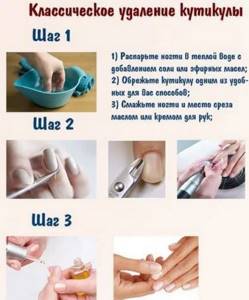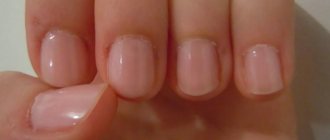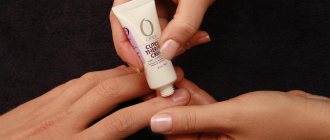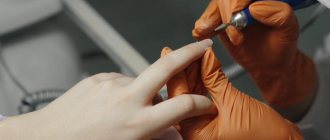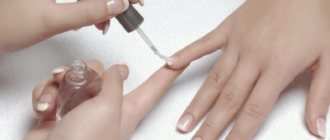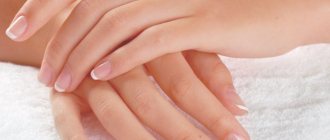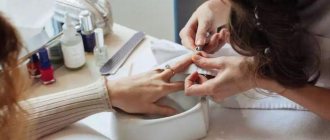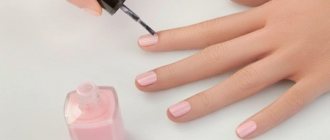It's easy to do a manicure yourself. Perhaps the most difficult part of this procedure is removing the cuticle. There are many options for dealing with skin growing on the nail, but not all of them are universal. Therefore, the fastest way to treat nails is to remove them with a special manicure tool - tweezers or skin nippers.
How to properly trim the cuticle with pliers so as not to injure the delicate skin of the nail fold? There is a special technique for this. Firstly, the nippers only work on steamed skin. After the bath, the tissues expand, are saturated with moisture, and soften. The difference between dead cells becomes visible - the skin in these places becomes white. Such areas must be removed. Secondly, the correct position of the tool during cutting is very important: along the side ridges the blades are parallel to the nail, and in the corners they become vertical.
Technique for working with pliers
The skin cut is made very shallow, the blades move parallel to the skin. All cuticle removal work is divided into two stages: on the right and left of the nail. How to do this is shown in the video.
The first movement of the blades starts from the edge of the side roller. The steamed skin is lightly grasped and the tweezers begin to move along the side roller, removing the keratinized area. As they move towards the lateral (posterior) roller, the tweezers take on a vertical position. This is necessary so that the cutting parts capture little skin. Such a small step is very maneuverable, it is easy for them to make a turn without injuring the client.
If the lateral roller is moved away and the eponychium is cleaned with a scraper, the blades on it take a horizontal position and remove a ribbon of skin along the entire length of the blades. After this, they move to the opposite side roller and work with it.
Here's how to properly trim your cuticles with cuticle cutters.
Cuticle tweezers
Many people prefer to use special tweezers called “cutters.” You need to buy them. Models designed for cutting nails are not at all suitable for removing cuticles. It is much easier for an inexperienced girl to cut the cuticle exactly with cuticle cutters. The technique of caring for cuticles using tweezers is much better suited for working at home. Let's take a closer look at it.
- Using a pusher, gently push back the cuticle, separating it from the nail. Do not put strong pressure on the nail bed so as not to injure it. If you don't have a pusher, you can use an orange stick for these purposes.
- First, work on the corners of your nails, removing any sharp edges. This is necessary to ensure that the side bolsters always remain in good condition and do not become rough.
- Now treat your nails with a nail file, giving them the correct shape. It is best to use a glass tool.
- Keep your hands in the bath for about three minutes. The water should not be very hot - a temperature of 36-38 °C is quite enough.
- Dry your fingers with a towel. There is no need to be too zealous - just lightly blot away excess moisture.
- Gently push back the softened cuticle with a pusher to make it more convenient for you to work.
- Now let's move on to working with tweezers. Start processing with the side rollers, gradually moving from the corners to the cuticle. Try to cut off excess skin evenly, without leaving burrs.
- Lastly, we trim the cuticle. This should be done carefully, slowly, trying to cut off unnecessary skin in one even strip. This guarantees you that the next day after your manicure, unsightly hangnails will not appear.
- Soak your nails in the bath for another minute and dry your hands with a towel.
This concludes the classic trimmed manicure at home using tweezers. All you have to do is apply a nourishing or moisturizing cream to your hands. It is useful to lubricate the nails and the skin around them with a special cuticle oil, which provides complete care. You can get a visual idea of the procedure and learn about some of the subtleties of its implementation while watching a detailed video.
Unedged manicure, which is popular today, minimizes the risk of damage to living tissue, but does not always give the desired result. In cases where the cuticle is very thick, grows quickly or is in a neglected state, it is possible to bring the nails into a well-groomed appearance only with the help of a trimmed manicure. Learning how to do it is not at all difficult. The main thing is to carefully read our step-by-step instructions and try to adhere to the basic rules. To consolidate the knowledge gained, we invite you to watch another video in which you will find the technique of trimming a manicure using tweezers.
Position of the tool in the hand
To control the movements of the instrument, it is important to hold it correctly. Good nippers lie comfortably in the hand, so the craftsman only needs to squeeze his palm lightly to make a cut. If the tweezers are not the right size, your hand will get tired. You have to strain your wrist or hold the instrument with your fingers. All this affects the maneuverability and quality of the cut.
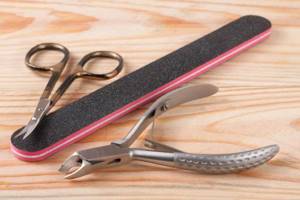
Over time, with constant overstrain, inflammation of the nerve passing in the carpal tunnel occurs. This is the so-called tunnel syndrome. In addition to manicurists, computer gamers and hand embroiderers also suffer from this problem. That's why nail schools teach how to use cuticle nippers. The cut is performed while holding the client's finger from below.
Cuticle nippers
In many ways, the success of a beautiful, even cut depends not on the craftsman, but on the quality of the cutting tool. There is a large selection on sale - for every taste, size and budget. And yet, how to determine which cuticle nippers are good and which are not? Experts advise how to choose a good tool:
- The blades should fit snugly against each other, there should not be the slightest gap between them.
- The ends of the blades must be sharp and must not differ.
- The blades must be well sharpened.
- There should be no rust on the instrument.
- The movement of the blades should be soft and easy.

A professional tool should not be cheap. During constant operation, it is subjected to sterilization in solutions, calcination in a dry-heat oven, and periodic sharpening. Cheap metal will simply crumble under such a load.
Sharp tools - high speed
The new tool makes an even cut, leaving no burrs and the skin on the back roller after the manicure is smooth and even. But if the blades begin to pull the skin and do not cut it off the first time, if you have to press hard on the blades, it means they have become dull and it’s time to take the nippers to a workshop to sharpen them.
To extend the life of the cutters, ensure that they are soaked in a disinfectant solution for a limited time. You should not keep them in it for longer than the time specified according to the instructions. The same principle applies to calcination in a sterilizer. This ruins the blades, and they have to be sharpened more often. It will take more time to do a manicure, since you won’t be able to quickly trim the cuticle with clippers. After working with dull blades, cuts are more likely to occur, burrs remain on the roller, and the cut itself will be uneven.
Cuticle care
To get neat, beautiful cuticles, it is not enough to remove them from time to time. Special products will help maintain the skin around the nail in well-groomed condition: oils and creams. They will moisturize the cuticle, preventing the appearance of cracks and hangnails, and can even slow down skin growth. We dedicate time to such care every day - you can arrange a whole ritual, taking into account the amazing aromas of the products 

We also recommend using gloves when cleaning, especially when in contact with chemicals. To completely minimize the harmful effects on the skin, and therefore the cuticle!

-29%
Domix, Cherry Syrup Nail Oil, 30 ml
Oil for nails and cuticles with the aroma of ripe cherries.
246 RUR 174 RUR
246 RUR 174 RUR Buy
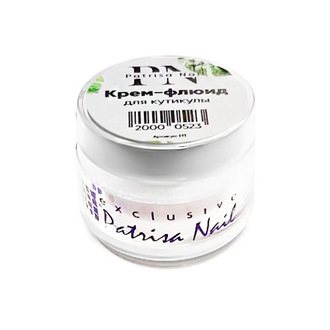
Cuticle cutting with scissors
Pedicures often involve trimming cuticles with scissors. They have much longer blades, which is very convenient for treating toenails. Some people ask: what is better to trim the cuticle: with scissors or nippers? The answer to this question can only be given by the master himself. For some operations he can use one tool, for others - two. It all depends on the task that faces him.
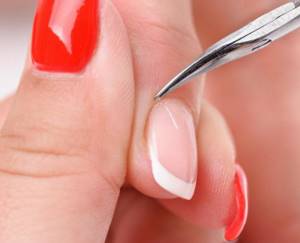
The blades of the scissors are more difficult to position vertically at the corners of the nails where the ridges meet. It is more convenient to work with tweezers here. It’s better to cut straight areas with scissors. It turns out smoother and faster. Scissors have straight blades, while tweezers have angled blades. Therefore, it is impossible to reach deep skin with scissors.
In general, tweezers are considered a universal tool, which is why they are in great demand. Although in some operations they are inferior to scissors in speed, they do not have to be changed during nail treatment.
Untrimmed cuticle removal method
Working with a cutting tool can cause a wound. Even experienced craftsmen sometimes injure a client. To avoid this, there is a method of unedged manicure, which can be manual or hardware. The manual method is a system of files that replace each other and file away dry areas of the skin. Almost like a pedicure.
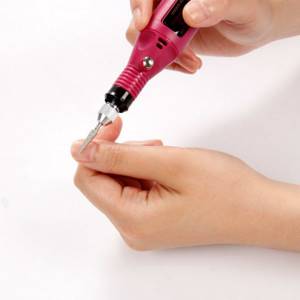
Hardware manicure is performed using an abrasive cutter. The principle is the same as for manual processing, only without files. You won’t be able to remove a lot of excess from the cuticle. Therefore, many people like the trimming method because the processing result is more obvious.
The master sometimes uses wire cutters after completing the work with the device. This is how he combines two techniques and achieves speed and quality of manicure.
A method for safely removing overgrown keratinized cuticle.
Once you've finished filing and creating the desired shape of your nails, treat them with an antiseptic.
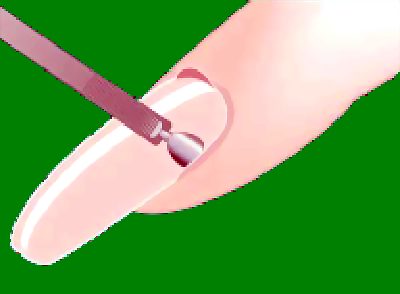
Take a metal curette and use it to separate the pterygium and cuticle from the surface of the nail. Why do I focus on the word metal, because the use of orange sticks is in most cases ineffective and even dangerous.
Be sure to apply a keratolytic agent to the cuticle to soften dead skin. The exposure time is determined visually; it usually ranges from 5 to 10 minutes, depending on the state of keratinization of the cuticle.
Remove any remaining product until the cuticle is completely dry.
Using a curette, try to lift the cuticle, giving it as vertical a position as possible. You should have a fence around the edge of the nail.
Cuticle cutting technique - angle method
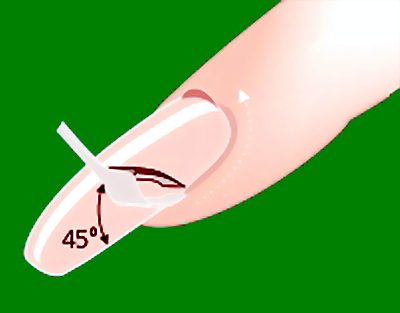
Technique for performing all subsequent cuts:
Place the lower incisor of the nippers under the cuticle, then squeeze the nippers and move them back in the closed state, so you will get an even cut and not nip off the cuticle.
When trimming the cuticle, adhere to the following rules:
- never pull the cuticle towards you;
- do not press the cuticle and surrounding soft tissues with the cutting part of the nippers;
- Watch the lower incisor of the pliers; its reverse side or jaw during trimming should fit tightly to the surface of the nail, as if sliding along it. This will prevent the upper incisor from capturing the living epithelium during circumcision, otherwise such trimming will lead to the appearance of hangnails 3-4 days after the cuticle cutting procedure.
Make all subsequent cuts in the same way, but the angle of inclination of the cuticle in relation to the plane of the cuticle should gradually decrease with each new cut, since with a sharp change in the inclination of the cut, the appearance of burrs is inevitable.
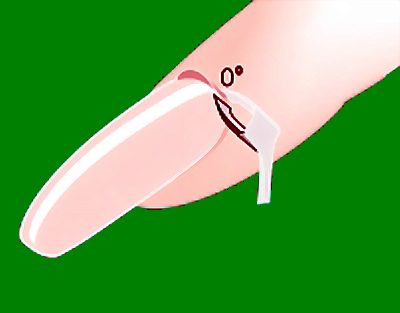
Rule: the initial angle of the nippers of 45 degrees should smoothly decrease with each cut and in the center of the nail should disappear to zero or 0 degrees.
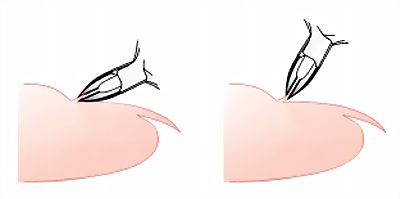
Next, cutting off the left side of the cuticle, the angle of inclination of the nippers gradually increases, from the center to the edge until it reaches the same 45 degrees in the area of the left nail fold. Ideally, you should get a beautiful thin roll of healthy cuticle without wounds or tissue cuts.
Necessary operations after cuticle removal
Immediately after removing cuticles, apply oil to the cuticles to treat and refresh them. The applied oil will create a barrier to the evaporation of moisture; previously this barrier was the removed keratinized cuticle, so the oil, even for a short time, will create a healing barrier for the matrix. It is the oil that helps wounds heal faster and prevents the formation of hangnails.
Conclusions:
- It is necessary to trim only the keratinized excess cuticle without affecting living tissue.
- Be sure to use keratolytic preparations to soften the cuticle; they damage the skin less than alkaline ones - for example, soap and steaming widely used at home.
- To avoid the formation of hangnails, the cuticle should be cut off and not bitten off or, even worse, torn off; remember, the quality of the manicure you have done will become obvious only 3-4 days after the cuticle removal procedure.
- Applying oil after cuticle removal surgery is mandatory; it improves the condition of the matrix and prevents the formation of hangnails.
Related posts:
- Essential oil recipes for treating and eliminating nail defects
- Silk for nail repair
- Why do fingernails peel?
Copy to your page
Expert advice
For beginners, it is important to find your own convenient way to remove cuticles with cuticle cutters. Since masters can do this with any tool, they advise trying all methods. There is no need to try to do everything perfectly. This may cause cuts. The cuticle has uneven thickness throughout. If you remove excess skin, you will get an uneven cut. Therefore, aesthetic principles should be followed regarding the amount of tissue removed.
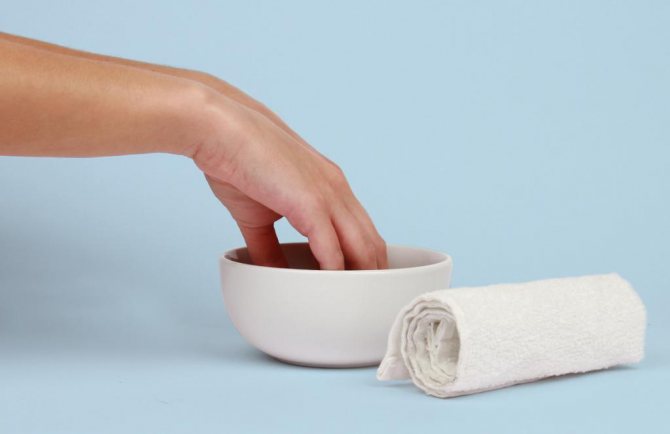
A lot, if not everything, depends on the quality preparation of hands for manicure. This includes a hot bath with soapy water. It loosens the keratin fibers and the master sees whitened areas on the fingers with hyperkeratosis. They are removed. A salt solution, on the contrary, will not allow the skin to absorb the required amount of water. But it will whiten your hands and nails.
The process of steaming in a soapy solution can be successfully replaced with a cuticle remover. Often this method of loosening the keratin of the skin is used before applying gel polish, when the nails should be dry. This composition is applied to the cuticle area, and after a while the roller is removed.
Classic manicure
Trimming manicure requires more preparation, attentiveness and accuracy; it is better to trust it to professionals. But, if you are confident in yourself, this method can also be used at home.

Full instructions are appropriate here:
- Before the procedure, do not forget to treat your instruments and hands with an antiseptic. Of course, we sterilize everything first - this is the default.
- Steam the cuticle in the bath. You can have a spa moment by adding aroma oils and sea salt, or simply make a soap solution. Afterwards, wipe your hands dry with a towel.
- Use a pusher or an orange stick to push back the cuticle and thoroughly clean the nail plate. There should be no difficulties with steamed cuticle.
- To remove, use forceps or cuticle scissors. Here the choice is yours - as you wish. Please note that the tools must be well sharpened. Oddly enough, the risk of injuring the skin with dull blades is higher. It is more convenient to start from the sides and finish in the middle. Ideally, we cut straight the first time to avoid burrs in the future.
- Do not try to remove as much as possible; it is better to remove a thin, neat strip. And remember that the cuticle still performs a protective function, which means you shouldn’t cut it at the root.
Silver Star, Leather scissors “Classic”, НСС 5 HG
Manicure scissors for leather. Scissors size 105mm. Blade size 23mm. Gold plated finish. Hardness - 42-44 HRC
(23)
572 RUR
572 RUR Buy
Silver Star, Cuticle Nipper “Classic”, AT 1105 (5mm)
Manicure tongs for leather. The size of the tongs is 100 mm. Blade size - 5 mm. Double spring. Silicone handles. Hardness - 42-44 HRC
(13)
778 RUR
778 RUR Buy
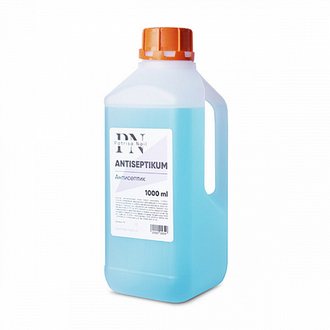
Patrisa Nail, Disinfectant Liquid, 1000 ml
Disinfectant for hands and tools. Alcohol content: not less than 60%.
(55)
RUB 1,850
RUB 1,850 Buy
We talked about two ways to remove cuticles, but we also remember about hardware manicure. It’s just that this option requires special preparation, and a description of the technique will not be enough to perform it. Manicure machines operate at high speed; with sharp cutters it is very easy to damage not only the thin skin, but also the nail, and even the hand. To remove cuticles with a device, it is better to undergo special training, at least start with our webinar. For a classic manicure, special preparation will also not be superfluous. 

Hardware manicure courses
(17)
600 RUR 499 RUR
Classic and hot manicure courses
(2)
600 RUR 499 RUR
Common Mistakes
There are some subtleties in how to cut cuticles with cuticle cutters. Very often, beginners forget to push the roller away with the pusher. This is a manicure spatula. Where the pterygium is not steamed enough, the roller will not move away. A sinus should open between the nail and the roller - a pocket formed by a fold of skin. Then you can clean the pterygium with a scraper - a manicure hatchet.
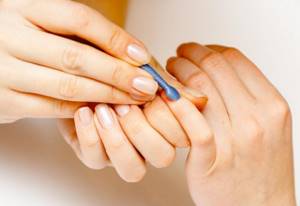
And only after this preparatory stage is completed, you can begin to remove excess skin. If some part of the roller remains attached to the nail, and the master did not notice it, when cutting the skin with a ribbon, there will be a cut there.
When working with nippers in the corners of the rollers, the main task is not to remove the entire cuticle, but to make a beautiful cut. It happens that in the pursuit of perfect processing, a lot of bites are formed in this place with tweezers, which, due to the vertical position of the blades, extend quite high onto the lateral roller. As a result, the cuticle cut line becomes beautiful, and the roller remains without skin.
How to remove cuticles at home
Since once every 3-3.5 months a girl needs to take a break without applying decorative coating or extensions at this time, she needs to know how to treat her nails on her own, avoiding damage to them.
When carrying out home manipulations, set aside 1-1.5 hours for them, since without skill it is quite difficult to remove the cuticle yourself while maintaining the health of the periungual area. Excessive haste will only increase the risk of skin damage.

The basic technology of manicure remains the same, but it is not always possible to perform it correctly at home, so you should follow some tips:
- If there is a hangnail, it must be carefully removed with nail scissors or tongs, and then treated with an antiseptic to prevent infection;
- When using the device, turn it on at minimum speed to avoid accidental damage to the sensitive area. Before using the device, you must undergo training;
- If you have a decorative coating on your nails, do not remove the cuticle. Most likely, you will not be able to do it carefully, which will ruin the visual condition of the manicure;
- Always be sure to soften the keratinized epidermis before removing or pushing it away. When working with dry skin, there is a risk of damage to the upper stratum corneum, which causes grooves and chips to form. Besides, doing this will be inconvenient;
- After treatment, it is recommended to apply essential oil and give a short massage to the delicate area. This way you will speed up blood circulation, metabolism in cells, and nourish the skin with oil, which will prevent the occurrence of hangnails or strong growths on the coating.
It is not recommended to perform manipulations too often. Adults should have a full manicure or pedicure every 1.5-2 weeks, children - once every 3 weeks.
Features of the procedure
The cuticle is a very delicate place. There are many blood capillaries here, and it can be very difficult to stop bleeding. But if a cut does occur, it is treated with the attached cotton swab dipped in hydrogen peroxide. In order to stop the bleeding, the hand is raised up.
In applying “under the cuticle” coatings, the first step is its removal. If you allow a wound in this area, no coating will stick. Therefore, experts advise how to properly trim the cuticle with cuticle cutters:
- First, the lateral cushion is moved back and slightly raised.
- The eponychium is then separated from the nail plateau. And where it sticks tightly to the nail, you can use a pusher and clean it off. For the same purposes, a “ceramic hoof” tool is used.
- After complete cleansing of the nail, flaps of skin remain, which are cut off with tweezers.
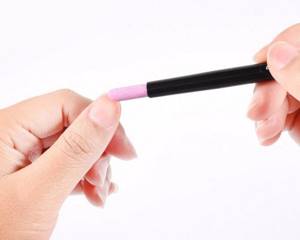
As you can see, preliminary preparation is extremely important and is an integral part of working with a cutting tool.
To ensure that cuticle removal does not lead to bad consequences, adhere to the following rules:
1. There is no need to remove it too often, as this may cause the nail fold to become dry and the cuticle to grow larger. 2. Try to cut it evenly the first time. After all, the remaining part of the cuticle on the nail dries out and becomes a hangnail. 3. Remove only the dead part. Touching the living part of the skin roll is accompanied by pain and cuts. 4. Before removing the cuticle, it needs to be softened using hand baths.
